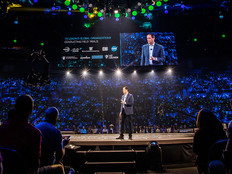Public Cloud Use to Soar in Years Ahead, Report Says
Get ready for a cloudy future.
Public cloud services will be more widely used in the next few years and cloud services will soon make up nearly all traffic in global data services, according to a report released Feb. 5 by Cisco Systems.
The report, Cisco's "Global Cloud Index," found that cloud traffic will grow 3.3-fold from 6 zettabytes in 2016 to 19.5 zettabytes in 2021. Just for a sense of scale, 1 zettabyte equals 1 trillion gigabytes. By 2021, cloud services will account for 95 percent of all data center traffic, up from 88 percent in 2016.
That's not surprising, since, according to the report, more businesses and users will access cloud-based services on their devices. By 2021, 94 percent of all workloads and compute instances will be cloud-based, up from 83 percent in 2016.
And, more of those cloud services will run on public cloud infrastructure, according to the Cisco report. Globally, the percentage of cloud services running in public clouds from Microsoft, Google and others will increase from 58 percent in 2016 to 73 percent in 2021.
Meanwhile, the Cisco report also forecast that software-defined networking (SDN) will become more prevalent in the years ahead as organizations look to virtualize their networks and gain more flexibility in how they control and deploy network services.
SIGN UP: Get more news from the BizTech newsletter in your inbox every two weeks!
Public Cloud Adoption to Spike
The number of workloads running in public clouds will grow at a 28 percent compound annual growth rate between 2016 and 2021, according to the report. Further, the workload and compute instance density — a measure of the number of workloads per server — for public cloud data centers is projected to grow from 9.1 in 2016 to 13.9 in 2021.
In comparison, that figure for private cloud data center will grow from 8.4 in 2016 to 11.5 in 2021, Cisco says. The workload density for traditional data centers will only increase from 2.4 in 2016 to 3.8 in 2021.
In 2021, roughly three-quarters of all enterprise compute applications will be in the public cloud, according to the Cisco report. About half of all database, analytics and Internet of Things applications will run via the public cloud, the report says, and the same is true for enterprise resource planning and other business apps.
Thomas Barnett, director of thought leadership in Cisco's worldwide service provider marketing group, notes that on-premises data centers will not totally go away, and that there will likely always be some enterprise-specific apps that cannot be run in public clouds for business or security reasons. However, he says, "the number of those are dwindling."
Increased adoption toward virtualization and containerization makes public cloud adoption more economical for organizations, Barnett says. He adds that Cisco and other vendors are working on new security solutions to make public cloud environments even more secure, though he acknowledges that more work needs to be done.
Shruti Jain, a senior analyst on Cisco's service provider marketing thought leadership team, says most large enterprises are adopting public cloud but will likely continue to run hybrid cloud environments that mix public and private clouds. "Hybrid cloud is probably the way most will go," she says.
Small and medium-sized businesses can now increasingly access cloud services that offer them a way to level the playing field with larger enterprises, Barnett says. "With public cloud and the portfolio of managed services that now can be offered through the cloud, that allows an SMB to have a service that is right-sized or scalable to them, or to have the same capabilities that a large enterprise might be managing themselves," he says.
SDN Will Take Off in the Years Ahead
Another trend the Cisco report highlights is the expected uptick in adoption of software-defined networking.
SDN separates the network configuration operations from data transmission, meaning an application itself can define the network it needs by specifying a set of rules or policies. Doing so means all applications can ensure that appropriate bandwidth and proper security objectives are achieved. SDNs also cut the amount of time network engineers must devote to mundane changes, allowing them to focus on more meaningful activities.
By 2021, Cisco predicts that 67 percent of all data centers worldwide will have completely or partially adopted SDN, up from 16 percent in 2016 and 24 percent in 2017.
SDN, Barnett notes, allows service providers and organizations to deploy new network services more quickly and manage them more efficiently. "You're able to get more information or data about the efficiency or optimization of your network than you were before," he says.









